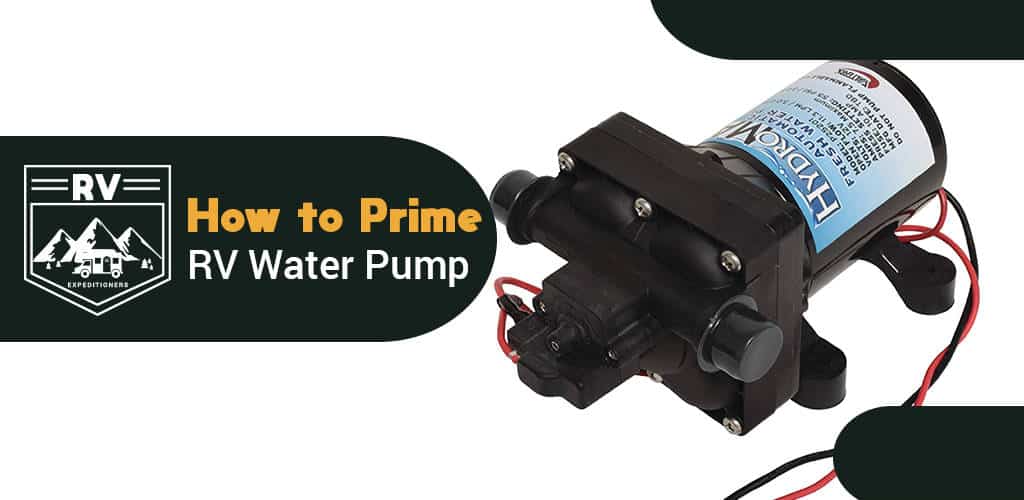You are the proud owner of a recreational vehicle (RV). The great outdoors is nothing new to you. Setting up a campsite is your sixth sense. Survival is your middle name. You understand the importance of preparing for the unexpected. So, going without water on your next adventure is a recipe for disaster.
The RV water pump is the solution. An RV water pump stores between 50 and 200 gallons of fresh water. It works by drawing water up from the tank. RV water pumps usually come in 12 or 24 volts, with the standard being 12V.
Even though RV water pumps are typically problem-free, the biggest issue you’ll probably face is the loss of pressure. Most RV owners notice this when they don’t use their water pumps for a while. The good news is that priming your pump will bring it back to life. This guide will show you how. Here’s what you’ll need:
Tools Needed
- Jar.
- Flathead screwdriver.
- Rubber tubing.
- Water.
Step-by-Step Guide
Now that you have your items, let’s get down to business. First, start by locating your water pump. Try looking under the bench seats or in cabinets. If you still have trouble locating the pump, open the cabinet under the kitchen sink and trace your water line back to the pump.
1. Detach the water outlet from the RV water pump. The clear plastic outlet line goes from the water pump into the RV, where it feeds into sinks, showers and toilets. Now, turn the screw on the collar counterclockwise. Repeat until you can pull the hose off.
2. Take the collar off the outlet line and on to the end of the rubber hose. Next, you want to take the rubber hose and attach it to the outlet spouting on your RV water pump. You can do this by screwing the clamp all the way down. Please make sure that your rubber hose is the same size as your water line. They should both be long enough to reach out from behind or under where your RV water pump is located.
3. Fill your jar with around 12 ounces of water. Hold up the hose connected to the outlet so that it is pointing up in the air. Make sure the hose is higher than the level of the pump. Now, you can pour the water inside the hose. Put your thumb on top of the hose. Turn on the pump. It takes a minute or two to build up pressure. Do you feel the water against your thumb? If so, you are all set. You can turn off the pump.
4. Finally, take the hose off the pump and connect the water line again. Next, turn on a faucet in your RV. Also, turn on your water pump. In a few seconds, you should see water running out of the faucet. You can now turn off both the faucet and the pump. Congratulations, you have primed your RV water pump.
TipsWe want to make sure that priming your pump is a smooth and easy process. So we will share these useful tips and warnings with you.
- Use a hose designed solely for drinking water, and do not use the hose for any other purpose so the hose remains sanitary. Bacteria inside the hose have the ability to leak into your water tank which can make you sick.- If you do not have freshwater at your campsite, figure out how much water can hold in your RV’s tank. Water weighs 8 pounds per gallon, so a 50-pound holding tank adds 400 pounds to the RV.
- Trapped air in your RV’s water line means that the stream of water will not flow smoothly. Pouring a gallon of water into the line prevents trapped air. Once all of the air is removed, the water pressure will return back to normal.
- Priming a pump after storing it during the winter likely means that you have used antifreeze in your water lines. To clear the lines, open the faucet and keep the pump running until the water is clear. The goal is to make sure the pipes do not contain antifreeze. Leaving antifreeze in your water supply can cause serious health issues.
Conclusion
Priming an RV water pump is important for health and happiness — both yours and the RVs. Now that you know how to prime an RV water pump, you are ready to take your adventures on the road. You won't have to worry about the lack of water.


To power the water system, every RV comes with a 12-volt pump. However, if your RV’s water pump fails, you’ll have a serious water problem on your hands. This is why priming the water pump is critical. If your camper is new, or every six months, this task must be completed after it has been put on standby.